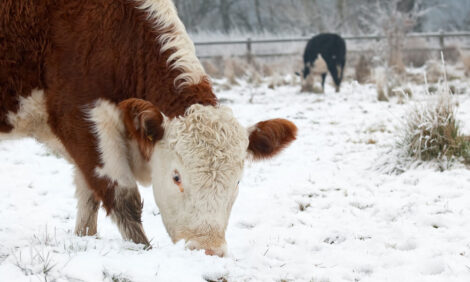



Management Practices to Improve Marbling and Beef Quality
CANADA - In Canada, meat quality is measured by the amount of intramuscular fat in the meat. This intramuscular fat is referred to as marbling. Marbling improves the flavor, juiciness and tenderness of beef.
The meat quality grades in Canada are A, AA, AAA, with single A grade beef having the least amount of marbling and triple AAA grade beef having the most. There is an exception to this, called Canadian Prime which has a slightly abundant amount of marbling.
“Intramuscular fat differs from subcutaneous fat in that subcutaneous fat is laid down on the outside of the carcass, while intramuscular fat is laid down within the muscle,” says Russel Horvey, beef forage specialist, Ag-Info Centre, Alberta Agriculture and Food, Stettler. “As the amount intramuscular fat or marbling increases, the quality of the beef improves. The opposite is true of subcutaneous fat. An excessive amount of this external fat lining the outside of the carcass reduces the quality and value of the beef.”
Fat is produced when the energy supplied exceeds the energy required for maintenance and production or growth in feeders. Therefore, extra energy in a diet will produce additional fat. Producers should note that intramuscular fat and subcutaneous fat are laid down differently. Intramuscular fat is laid down more slowly and is laid down continuously throughout the lifetime of a feeder, while subcutaneous (external) fat can be laid down more quickly towards the end of the growth curve, as the animal’s growth rate slows down.
“It is important for producers to understand the difference in how fat is laid down,” says Horvey. “If the slow continuous production of intramuscular fat is interrupted during the growth of a feeder, it can not be compensated for by feeding extra energy later in the finishing phase. This common practice only increases the amount of subcutaneous fat on a carcass.”
Drought, lack of milk, weaning, late castration and long distance trucking are a few examples of factors that can interrupt the production and deposition of intramuscular fat. Treating sick animals more than once has also been shown to reduce the likelihood of adequate marbling.
“Several management practices can be adopted to improve marbling in beef,” says Horvey. “First, however, cattle must have the genetics for marble, otherwise no management practice will improve marbling. Assuming the cattle have the genetics to marble, any management practice that reduces stress and does not limit the intake of high quality feed will encourage the continuous deposition of intramuscular fat, resulting in increased marbling. A few management things to consider include: early castration, creep feeding, low stress weaning, and vaccinating to reduce the likelihood of sickness.”
TheCattleSite News Desk


